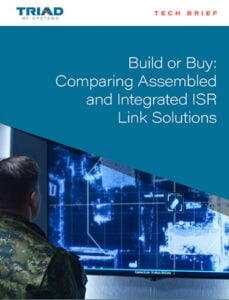 Triad RF Systems has released the following article, along with an accompanying tech brief, highlighting the hazards of using homegrown amplification solutions for extending the range of ISR radio links on UAVs (unmanned aerial vehicles) and other unmanned systems.
Triad RF Systems has released the following article, along with an accompanying tech brief, highlighting the hazards of using homegrown amplification solutions for extending the range of ISR radio links on UAVs (unmanned aerial vehicles) and other unmanned systems.
The tech brief, titled “Build or Buy: Comparing Assembled and Integrated ISR Link Solutions”, can be downloaded from Triad’s website here.
Boosting the power and distance over which you can maintain the integrity of a radio’s output has never been more important than it is with the meteoric rise in unmanned systems. Distance, weather and power differentials can all contribute to signal degradation or slowdowns – any of which can cause fatal flaws in your ISR radio links. As you look for solutions to help boost signal strength and quality, it often becomes a question of whether to add new BDAs (bi-directional amplifiers), add more power, or to simply re-engineer your systems to provide a more consistent output over time. Triad has addressed this challenge with our new line of Amplified Radio Systems.
Addressing the Build vs. Buy Decision
Engineers have been asking this question for generations: Is it better to build necessary functionality from scratch or find a pre-built solution that simply needs to be customized? While it is often tempting to build something that precisely fits your unique scenario and operational requirements, it’s not unusual for these homegrown solutions to suffer from signal degradation, particularly over long distances. These in-house integrations frequently fail to achieve the size, weight, performance, and cost objectives (SWaP-C) required of a long-distance radio link. Unmanned aerial vehicles/systems (UAV/UAS) and ground/surface vehicles (UGV/USV) that frequently operate in harsh weather conditions and challenging terrain are common applications where Triad Amplified Radio Systems are finding the best use.
Turning to a bolt-on ISR data link solution is not an unusual thing to do. In fact, some companies have complete RF/microwave integration teams for this necessity. But the unfortunate reality is that each bi-directional amplifier (BDA) that is added to your system has the potential to reduce the overall performance of your link. Plus, each integration point leaves yet another connection that will require troubleshooting if you’re having problems with signal strength and quality. Even a slight shift in power drift due to temperature outputs can significantly impact performance, with each additional BDA causing stacked issues that can affect the range of a link by up to 30% over a single flight test. A primary issue routinely uncovered during in-house integration is that creating a dependable long-distance radio link requires extensive expertise in the optimization of RF margins. It’s usually discovered of course long after the decision to integrate in-house has been made.
Our RF amplifiers and ISR link solutions deliver in even the most challenging conditions, providing your operators with the added confidence of knowing that signals will be crisp and clear.
A Tech Brief comparing the various tradeoffs related to self-assembly vs. purchasing turnkey Triad amplified radios is available here: www.triadrf.com/updates/tech-brief-build-or-buy-comparing-assembled-and-integrated-isr-link-solutions/










